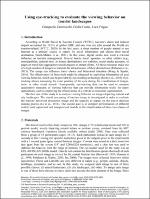Chapter Using eye-tracking to evaluate the viewing behavior on tourist landscapes
Author(s)
Zammarchi, Gianpaolo
contu, giulia
Frigau, Luca
Language
EnglishAbstract
Every tourist website employs images to attract potential tourists. In particular, destination tourism websites use environmental images, such as landscapes, to attract the attention of tourists and to address their purchase choice. Nowadays the effectiveness of these tools has been enhanced by the use of eye-tracking technology. That allows measuring the exact eye position during the visualization of images, texts, or other visual stimuli. Consequently, eye-tracking data can be processed to obtain quantitative measures of viewing behavior that can be analyzed for several purposes in many fields such as to cluster consumers, to improve the effectiveness of a website and for neuroscience studies. This work is aimed to use eye-tracking technology to investigate user behavior according to different types of images (e.g. natural landscapes, city landscapes). Specifically, we compare different statistical descriptive tools with supervised and unsupervised models. Furthermore, we discuss the effectiveness of their results and their capacity to provide satisfactory and interpretable solutions that can be used by decision-makers.


 Download
Download Web Shop
Web Shop